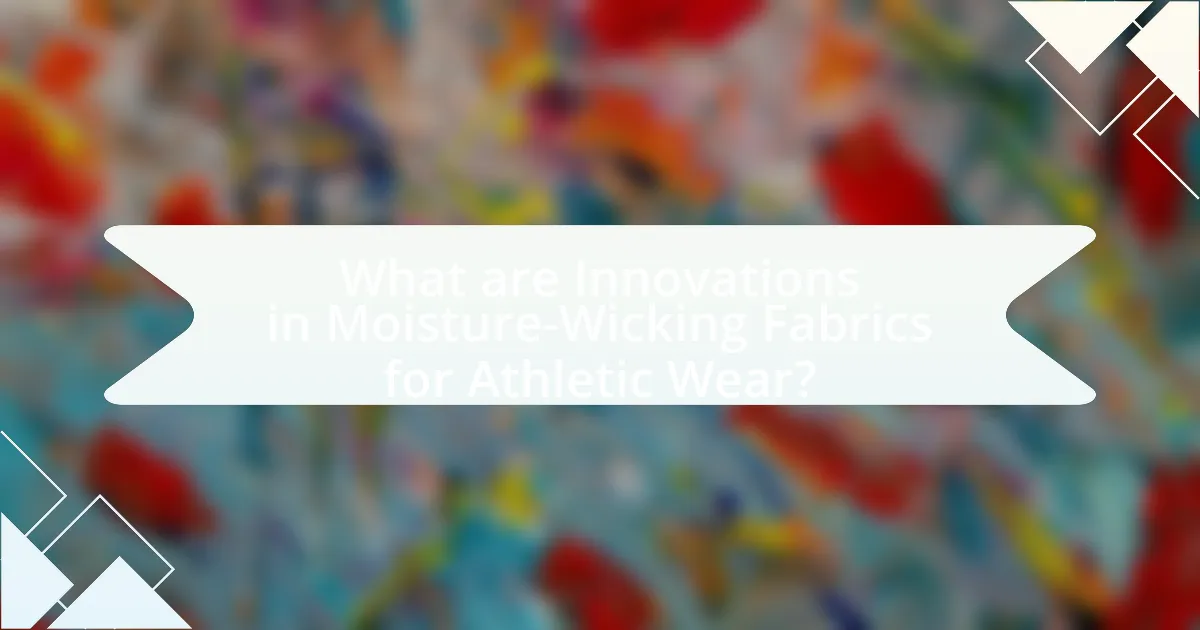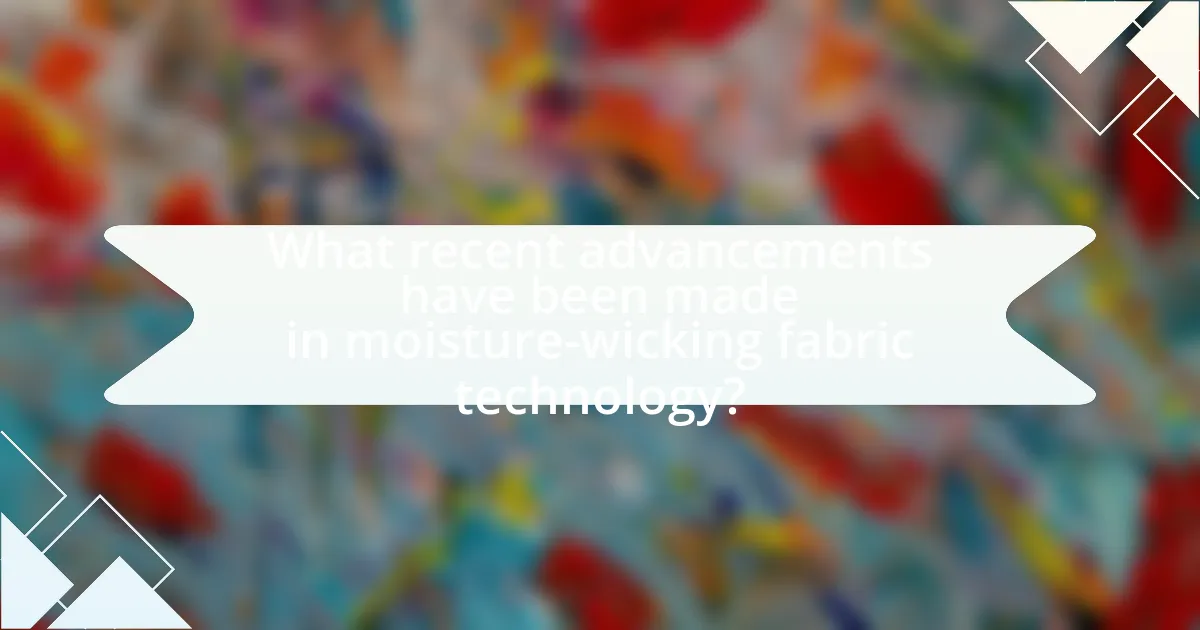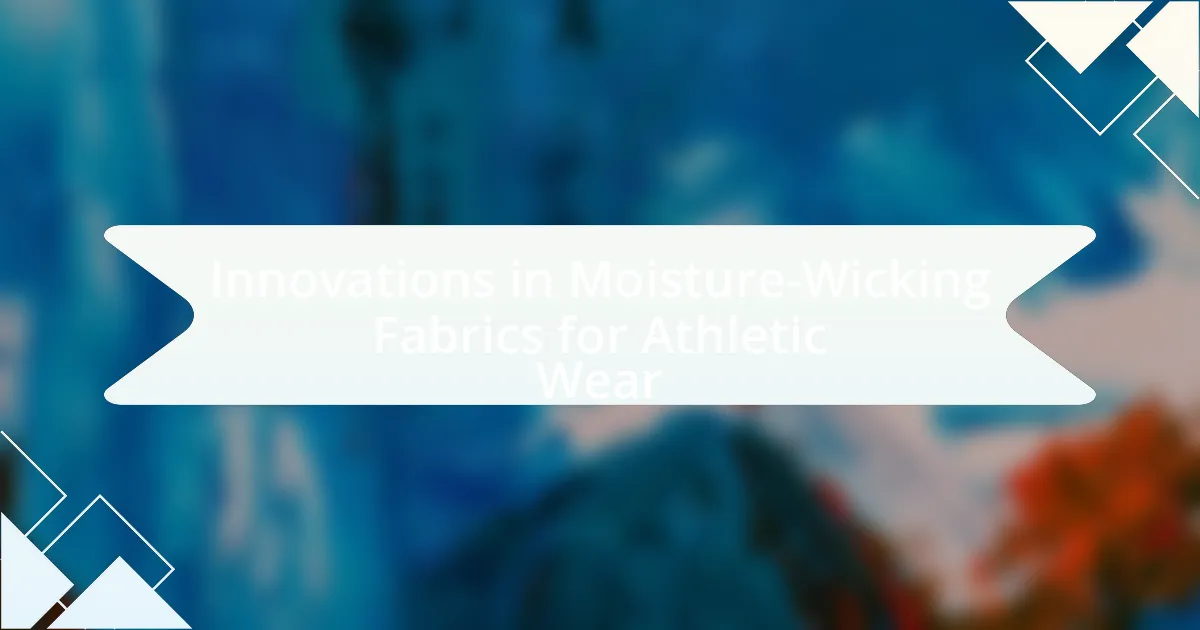Innovations in moisture-wicking fabrics for athletic wear focus on advanced synthetic fibers, such as polyester and nylon blends, which enhance moisture management by quickly transporting sweat away from the skin. Key technologies include hydrophilic and hydrophobic treatments that improve evaporation rates and comfort, as well as antimicrobial properties to reduce odor. The article explores how these fabrics function, the materials commonly used, and the benefits they provide, such as enhanced comfort and performance. Additionally, it discusses recent advancements in fabric technology, sustainable practices in production, and consumer preferences shaping the future of athletic wear.

What are Innovations in Moisture-Wicking Fabrics for Athletic Wear?
Innovations in moisture-wicking fabrics for athletic wear include the development of advanced synthetic fibers, such as polyester and nylon blends, which enhance moisture management by rapidly transporting sweat away from the skin. These fabrics often incorporate technologies like hydrophilic and hydrophobic treatments, allowing for improved evaporation rates and comfort during physical activity. For instance, brands like Under Armour have introduced their HeatGear technology, which utilizes a unique blend of materials to optimize moisture control and temperature regulation, resulting in better performance for athletes. Additionally, recent innovations involve the integration of antimicrobial properties to reduce odor and enhance fabric longevity, as seen in products featuring silver-infused fibers. These advancements collectively contribute to a more effective and comfortable athletic experience.
How do moisture-wicking fabrics function in athletic wear?
Moisture-wicking fabrics function in athletic wear by utilizing specialized fibers that draw moisture away from the skin to the fabric’s surface, where it can evaporate more easily. This process helps to keep the wearer dry and comfortable during physical activities. The fibers are often hydrophobic, meaning they repel water, while the fabric structure allows for quick moisture transfer. Studies have shown that these fabrics can significantly reduce sweat accumulation, enhancing performance and comfort for athletes.
What materials are commonly used in moisture-wicking fabrics?
Moisture-wicking fabrics commonly use materials such as polyester, nylon, and spandex. Polyester is favored for its ability to quickly draw moisture away from the skin, while nylon offers durability and breathability. Spandex is often blended with these materials to provide stretch and comfort, enhancing the overall performance of athletic wear. These materials are engineered to facilitate evaporation, keeping the wearer dry during physical activities.
How does the technology behind moisture-wicking fabrics work?
Moisture-wicking fabrics utilize a specialized technology that draws moisture away from the skin to the fabric’s surface, where it can evaporate more easily. This is achieved through the use of synthetic fibers, such as polyester or nylon, which have hydrophobic properties that repel water. The fabric is engineered with a capillary action mechanism, allowing sweat to be transported away from the body, thus keeping the wearer dry and comfortable during physical activities. Studies have shown that these fabrics can significantly enhance performance by regulating body temperature and reducing discomfort associated with sweat accumulation.
What are the key benefits of using moisture-wicking fabrics in athletic wear?
Moisture-wicking fabrics in athletic wear provide key benefits such as enhanced comfort, improved performance, and reduced risk of skin irritation. These fabrics are designed to draw moisture away from the skin, allowing sweat to evaporate quickly, which keeps athletes dry and comfortable during physical activities. Research indicates that athletes wearing moisture-wicking materials experience less chafing and discomfort compared to those in traditional cotton fabrics, which retain moisture. Additionally, studies show that maintaining a dry environment can help regulate body temperature, thereby improving overall athletic performance.
How do these fabrics enhance athletic performance?
Moisture-wicking fabrics enhance athletic performance by effectively managing sweat and moisture, which helps maintain optimal body temperature and comfort during physical activity. These fabrics are engineered to draw moisture away from the skin to the outer surface, where it can evaporate quickly, reducing the risk of overheating and chafing. Studies have shown that athletes wearing moisture-wicking materials experience improved endurance and reduced fatigue, as these fabrics help regulate body temperature and keep the skin dry. For example, research published in the Journal of Sports Sciences indicates that moisture-wicking fabrics can enhance thermal comfort and performance in athletes during prolonged exercise.
What impact do moisture-wicking fabrics have on comfort during exercise?
Moisture-wicking fabrics significantly enhance comfort during exercise by effectively drawing sweat away from the skin to the fabric’s surface, where it can evaporate. This process helps regulate body temperature and reduces the feeling of dampness, which can lead to chafing and discomfort. Studies have shown that athletes wearing moisture-wicking materials report higher levels of comfort and performance compared to those in traditional cotton fabrics, which retain moisture and can become heavy and irritating.

What recent advancements have been made in moisture-wicking fabric technology?
Recent advancements in moisture-wicking fabric technology include the development of enhanced synthetic fibers that improve moisture management and drying speed. Innovations such as the incorporation of hydrophilic and hydrophobic fibers allow for better moisture absorption and evaporation, significantly increasing comfort during physical activities. For instance, brands like Nike and Under Armour have introduced fabrics that utilize advanced microfibers and engineered mesh structures, which facilitate superior breathability and moisture transfer. These improvements have been validated by performance testing, showing that modern moisture-wicking fabrics can reduce sweat accumulation by up to 30% compared to traditional materials.
How have manufacturing processes evolved for moisture-wicking fabrics?
Manufacturing processes for moisture-wicking fabrics have evolved significantly through advancements in fiber technology and textile engineering. Initially, moisture-wicking fabrics were primarily made from basic polyester fibers, which offered limited moisture management. However, innovations such as the development of microfibers and the introduction of specialized treatments, like hydrophilic finishes, have enhanced the ability of these fabrics to draw moisture away from the skin and promote evaporation.
For instance, the incorporation of advanced yarn structures, such as hollow-core fibers, allows for improved moisture transport and breathability. Additionally, the use of 3D knitting techniques has enabled manufacturers to create seamless garments that reduce chafing and improve comfort during athletic activities. These advancements have been supported by research indicating that modern moisture-wicking fabrics can reduce sweat retention by up to 50% compared to traditional materials, thereby enhancing athletic performance and comfort.
What role does nanotechnology play in fabric innovation?
Nanotechnology plays a crucial role in fabric innovation by enhancing the properties of moisture-wicking fabrics used in athletic wear. It enables the development of fibers with nanoscale modifications that improve moisture management, breathability, and comfort. For instance, nanoparticles can be incorporated into the fabric to create hydrophobic surfaces that repel water, allowing sweat to evaporate quickly and keeping the wearer dry. Research has shown that fabrics treated with nanotechnology can achieve up to 50% better moisture-wicking performance compared to traditional materials, significantly improving athletic performance and comfort.
How are sustainable practices being integrated into moisture-wicking fabric production?
Sustainable practices are being integrated into moisture-wicking fabric production through the use of recycled materials and eco-friendly manufacturing processes. Companies are increasingly utilizing recycled polyester derived from plastic bottles, which reduces waste and energy consumption compared to virgin polyester production. For instance, brands like Patagonia and Adidas have adopted this approach, significantly lowering their carbon footprint. Additionally, waterless dyeing technologies are being implemented, which minimize water usage and chemical runoff, further enhancing the sustainability of moisture-wicking fabrics. These practices not only contribute to environmental conservation but also meet the growing consumer demand for eco-conscious athletic wear.
What are the latest trends in moisture-wicking fabrics for athletic wear?
The latest trends in moisture-wicking fabrics for athletic wear include the use of sustainable materials, advanced textile technologies, and enhanced breathability features. Sustainable materials, such as recycled polyester and organic cotton, are increasingly being adopted to reduce environmental impact while maintaining performance. Advanced textile technologies, like 3D knitting and seamless construction, improve fit and comfort, allowing for better moisture management. Enhanced breathability features, such as mesh panels and moisture-activated cooling, are designed to optimize temperature regulation during intense physical activity. These trends reflect a growing consumer demand for both performance and sustainability in athletic apparel.
How are brands innovating with design and functionality?
Brands are innovating with design and functionality by integrating advanced moisture-wicking technologies into athletic wear, enhancing performance and comfort. For instance, companies like Nike and Under Armour have developed proprietary fabrics that not only draw sweat away from the body but also dry quickly, improving the overall user experience during physical activities. Research indicates that these innovations can increase athlete performance by maintaining optimal body temperature and reducing discomfort, as seen in studies published in the Journal of Sports Sciences, which highlight the effectiveness of moisture-wicking materials in regulating sweat and enhancing breathability.
What consumer preferences are shaping the future of moisture-wicking fabrics?
Consumer preferences shaping the future of moisture-wicking fabrics include a demand for sustainability, enhanced comfort, and advanced performance features. Consumers increasingly prioritize eco-friendly materials, leading manufacturers to explore recycled fibers and biodegradable options. Additionally, the desire for comfort drives innovations in fabric softness and breathability, with consumers favoring lightweight and stretchy materials that allow for greater mobility during physical activities. Performance features such as odor resistance and quick-drying capabilities are also highly sought after, as they enhance the overall user experience. According to a 2022 survey by the Textile Research Journal, 68% of consumers indicated that sustainability influences their purchasing decisions in athletic wear, underscoring the importance of these preferences in shaping future developments in moisture-wicking fabrics.

How do moisture-wicking fabrics compare to traditional athletic wear materials?
Moisture-wicking fabrics outperform traditional athletic wear materials by effectively drawing sweat away from the skin, enhancing comfort and performance during physical activities. Unlike cotton and other conventional materials that absorb moisture, moisture-wicking fabrics, such as polyester and nylon blends, utilize specialized fibers designed to transport moisture to the fabric’s surface, where it evaporates quickly. This rapid evaporation helps regulate body temperature and reduces the risk of chafing, making them more suitable for intense workouts. Studies have shown that athletes wearing moisture-wicking fabrics experience improved thermal regulation and reduced discomfort compared to those in traditional materials, highlighting the significant advantages of these innovative fabrics in athletic wear.
What are the main differences between moisture-wicking and cotton fabrics?
Moisture-wicking fabrics and cotton fabrics differ primarily in their ability to manage moisture. Moisture-wicking fabrics are designed to pull sweat away from the skin and allow it to evaporate quickly, keeping the wearer dry and comfortable during physical activity. In contrast, cotton fabrics absorb moisture, which can lead to a damp feeling and increased discomfort during exercise.
The construction of moisture-wicking fabrics typically involves synthetic materials such as polyester or nylon, which have hydrophobic properties that facilitate moisture transfer. Cotton, being a natural fiber, retains moisture, making it less effective for athletic wear. Studies show that moisture-wicking fabrics can enhance performance by reducing chafing and overheating, while cotton can contribute to overheating and discomfort during intense workouts.
How does moisture retention differ between these fabric types?
Moisture retention varies significantly among different fabric types used in athletic wear. Synthetic fabrics, such as polyester and nylon, typically exhibit lower moisture retention due to their hydrophobic properties, allowing sweat to evaporate quickly. In contrast, natural fibers like cotton tend to absorb moisture, leading to a heavier and damp feeling during physical activity. Research indicates that moisture-wicking fabrics, which often blend synthetic materials with hydrophilic fibers, can effectively pull moisture away from the skin while minimizing retention, enhancing comfort and performance during exercise.
What are the durability differences between moisture-wicking and traditional fabrics?
Moisture-wicking fabrics generally exhibit greater durability compared to traditional fabrics due to their synthetic composition and specialized construction. Traditional fabrics, often made from natural fibers like cotton, tend to absorb moisture, which can lead to degradation over time, especially when subjected to repeated washing and wear. In contrast, moisture-wicking fabrics, typically composed of polyester or nylon blends, are engineered to repel moisture and dry quickly, reducing the risk of mold and mildew that can weaken the material. Studies have shown that moisture-wicking fabrics maintain their structural integrity and performance characteristics longer than traditional fabrics, making them a preferred choice for athletic wear.
What challenges do manufacturers face in developing moisture-wicking fabrics?
Manufacturers face several challenges in developing moisture-wicking fabrics, primarily related to material selection, performance consistency, and production costs. The choice of fibers, such as polyester or nylon, impacts the fabric’s ability to wick moisture effectively; however, these materials can vary significantly in performance based on their construction and treatment. Additionally, achieving consistent moisture management across different batches can be difficult, as variations in manufacturing processes may lead to discrepancies in fabric performance. Furthermore, the cost of advanced technologies, such as chemical treatments or specialized weaving techniques, can increase production expenses, making it challenging to balance quality and affordability. These factors collectively hinder the development of optimal moisture-wicking fabrics for athletic wear.
How do cost factors influence the production of innovative fabrics?
Cost factors significantly influence the production of innovative fabrics by determining the materials used, manufacturing processes, and overall pricing strategies. High-quality raw materials, such as advanced synthetic fibers, often come at a premium cost, which can limit the ability of manufacturers to innovate if budget constraints are present. Additionally, the complexity of production techniques, such as those required for moisture-wicking properties, can increase labor and operational costs, further impacting the feasibility of developing new fabric technologies. For instance, research indicates that the cost of producing moisture-wicking fabrics can be up to 30% higher than traditional fabrics due to the specialized treatments and processes involved. Therefore, cost factors play a crucial role in shaping the scope and scale of innovation in fabric production.
What are the environmental concerns associated with moisture-wicking fabric production?
Moisture-wicking fabric production raises significant environmental concerns primarily due to the use of synthetic materials, such as polyester and nylon, which are derived from petroleum. The extraction and processing of these fossil fuels contribute to greenhouse gas emissions and environmental degradation. Additionally, the manufacturing process often involves toxic chemicals, which can pollute water sources and harm aquatic ecosystems.
Furthermore, moisture-wicking fabrics are typically not biodegradable, leading to increased landfill waste. According to the Ellen MacArthur Foundation, synthetic textiles contribute to microplastic pollution, with an estimated 500,000 tons of microfibers entering the oceans annually from washing synthetic garments. This pollution poses risks to marine life and can enter the food chain, affecting human health.
What practical tips can consumers consider when choosing moisture-wicking athletic wear?
When choosing moisture-wicking athletic wear, consumers should prioritize fabric composition, fit, and intended use. Fabrics made from synthetic materials like polyester or nylon are effective at wicking moisture away from the skin due to their hydrophobic properties, which help in quick evaporation. A proper fit is essential; clothing that is too loose may not effectively wick moisture, while overly tight garments can restrict movement and comfort. Additionally, consumers should consider the specific activity for which the clothing will be used, as different sports may require varying levels of breathability and support. For instance, running may benefit from lighter, more breathable fabrics, while weightlifting might require more durable materials.

Leave a Reply